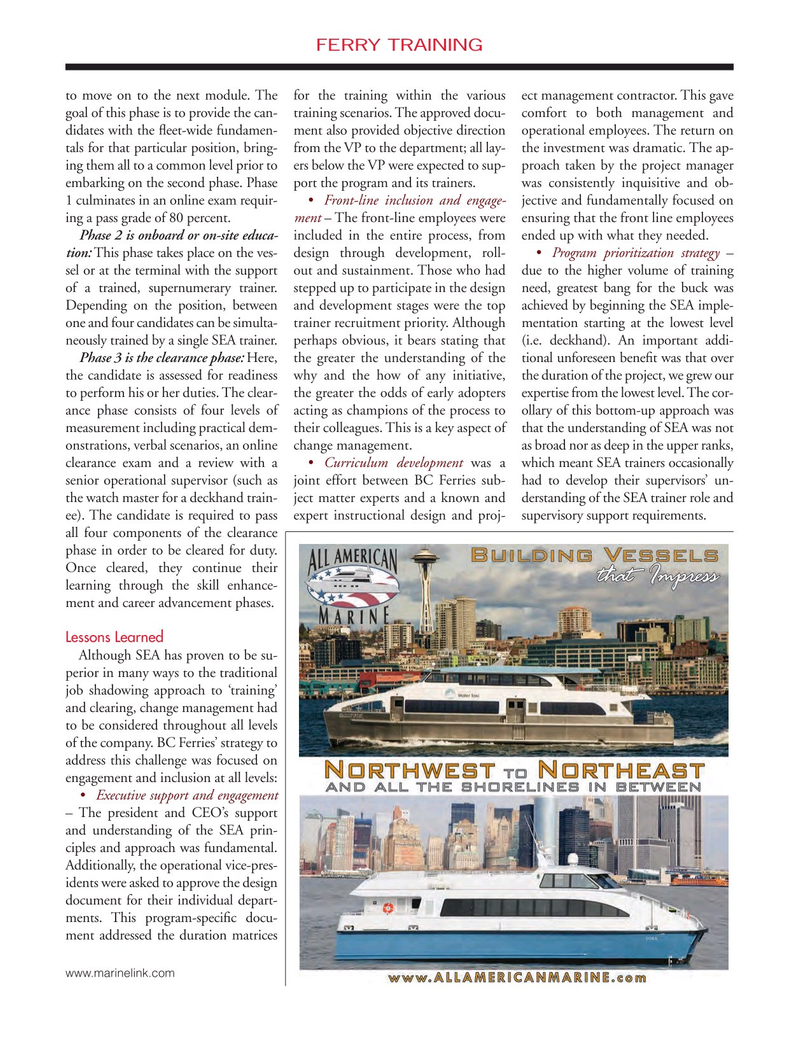
Page 25: of Marine News Magazine (January 2016)
Read this page in Pdf, Flash or Html5 edition of January 2016 Marine News Magazine
FERRY TRAINING to move on to the next module. The for the training within the various ect management contractor. This gave goal of this phase is to provide the can- training scenarios. The approved docu- comfort to both management and didates with the ? eet-wide fundamen- ment also provided objective direction operational employees. The return on tals for that particular position, bring- from the VP to the department; all lay- the investment was dramatic. The ap- ing them all to a common level prior to ers below the VP were expected to sup- proach taken by the project manager embarking on the second phase. Phase port the program and its trainers. was consistently inquisitive and ob- 1 culminates in an online exam requir- • Front-line inclusion and engage- jective and fundamentally focused on ing a pass grade of 80 percent. ment – The front-line employees were ensuring that the front line employees
Phase 2 is onboard or on-site educa- included in the entire process, from ended up with what they needed.
tion: This phase takes place on the ves- design through development, roll- • Program prioritization strategy – sel or at the terminal with the support out and sustainment. Those who had due to the higher volume of training of a trained, supernumerary trainer. stepped up to participate in the design need, greatest bang for the buck was
Depending on the position, between and development stages were the top achieved by beginning the SEA imple- one and four candidates can be simulta- trainer recruitment priority. Although mentation starting at the lowest level neously trained by a single SEA trainer. perhaps obvious, it bears stating that (i.e. deckhand). An important addi-
Phase 3 is the clearance phase: Here, the greater the understanding of the tional unforeseen bene? t was that over the candidate is assessed for readiness why and the how of any initiative, the duration of the project, we grew our to perform his or her duties. The clear- the greater the odds of early adopters expertise from the lowest level. The cor- ance phase consists of four levels of acting as champions of the process to ollary of this bottom-up approach was measurement including practical dem- their colleagues. This is a key aspect of that the understanding of SEA was not onstrations, verbal scenarios, an online change management. as broad nor as deep in the upper ranks, clearance exam and a review with a • Curriculum development was a which meant SEA trainers occasionally senior operational supervisor (such as joint effort between BC Ferries sub- had to develop their supervisors’ un- the watch master for a deckhand train- ject matter experts and a known and derstanding of the SEA trainer role and ee). The candidate is required to pass expert instructional design and proj- supervisory support requirements. all four components of the clearance phase in order to be cleared for duty.
Once cleared, they continue their learning through the skill enhance- ment and career advancement phases.
Lessons Learned
Although SEA has proven to be su- perior in many ways to the traditional job shadowing approach to ‘training’ and clearing, change management had to be considered throughout all levels of the company. BC Ferries’ strategy to address this challenge was focused on engagement and inclusion at all levels: • Executive support and engagement – The president and CEO’s support and understanding of the SEA prin- ciples and approach was fundamental.
Additionally, the operational vice-pres- idents were asked to approve the design document for their individual depart- ments. This program-speci? c docu- ment addressed the duration matrices www.marinelink.com
MN Jan16 Layout 18-31.indd 25 1/7/2016 10:13:47 AM

 24
24

 26
26
